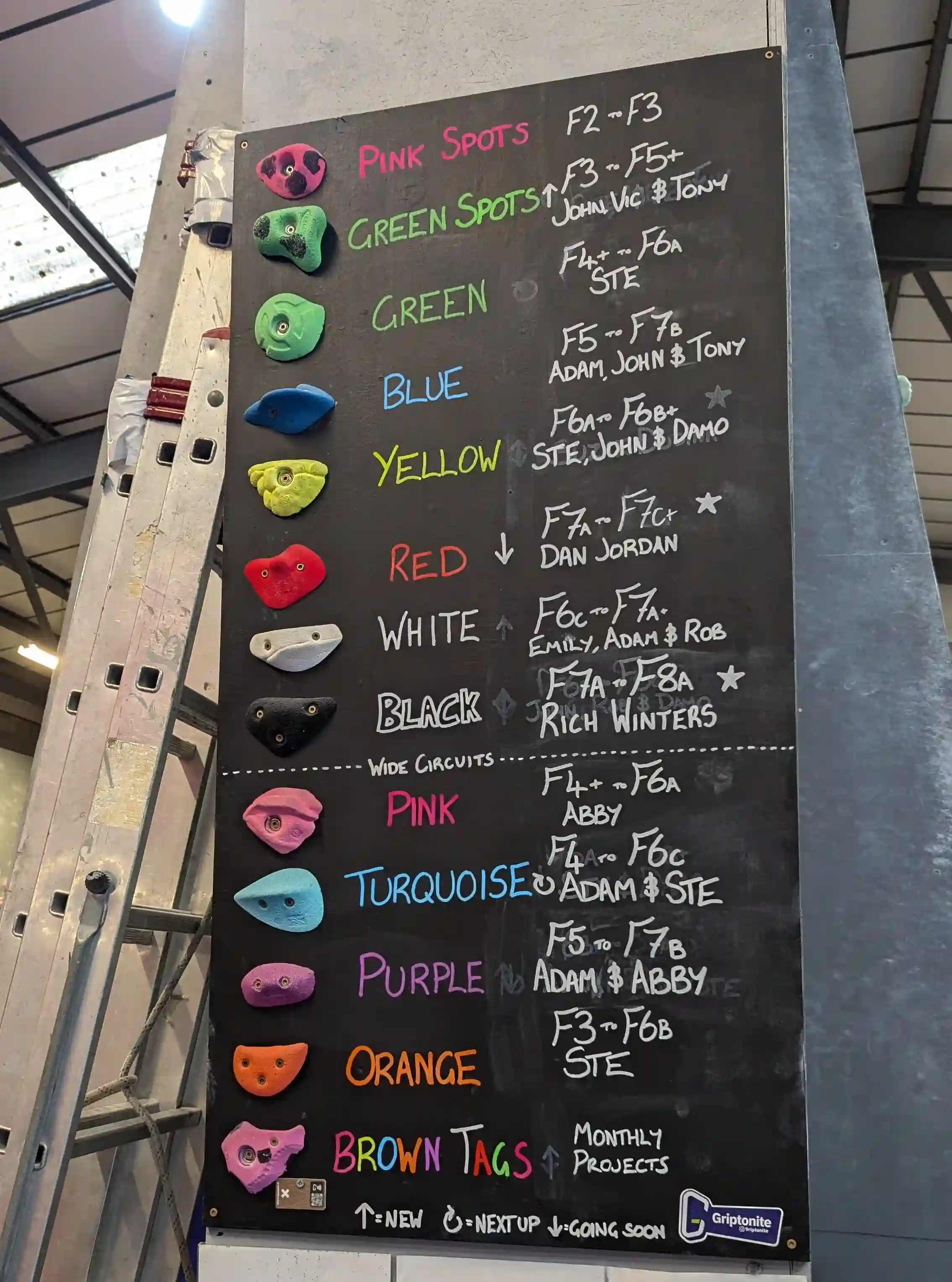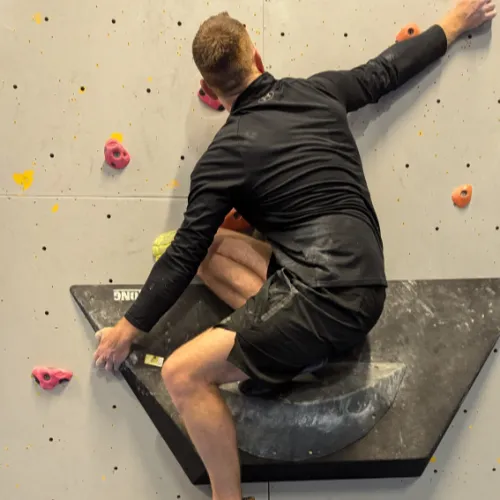Climbing Grades
When your first start going to bouldering / climbing gyms you'll see letters, tags and numbers next to holds, but what do they all mean? In this guide I'll show you the different grades and grading systems (there are quite a few!) and how you should start each route.
Climbing grades explained
You might have seen what appear to be random letter and numbers next to holds, such as 5A, 6B+ V1, V6, or just a number such as 4. What on earth do they all mean? These are all climbing grades and the represent how difficult a route will be. Generally speaking the higher the number, the harder the route. Also where you are in the world might also dictate what grade types you see.
So now you know that the higher the number the harder the route. Not so bad, see? Next let's move onto the different grading systems. I'll explain what the different numbers and letters mean.
Grading systems explained
The two most popular grading systems are the Font (fontainebleau) Scale and the V Scale. You'll see the Font Scale mostly used in Europe and the United Kingdom and the V Scale throughout the Americas.
The Font Scale
If you are from the United Kingdom or most of Europe you'll have seen the Font Scale being used in most of the climbing gyms you go to. The Font Scale uses numbers, letters and the plus symbol (+) to rank the difficultly of routes.
As it currently stands the Font Scale starts from 1A (easiest) and goes all the way up to 9A (hardest). This might change in the future as harder routes are discovered. Unlike the V Scale, the Font Scale doesn't just go up in numbers, the letters increment also. A being the easiest and C being the hardest.
For example a route could be a 6A, 6A+, 6B, 6B+, 6C or a 6C+. A 6B route is harder than a 6A and a 6A+ route. Another example is that a 6A+ route is harder than a 6A, but not quite as hard as a 6B.
You might also find that climbing gyms will group routes into different colours. Generally speaking there's no set rules as to which colour is linked to what range of grades. An example of this could be black coloured holds have a range between 6B to 7A+ or green coloured holds might be 5A to 6B. The climbing gym will usually have a sign or chalk board on display which tells you which routes have what colours. If you're in doubt, just ask the gym staff and they'll be happy to tell you.

The V Scale
The V Scale is very popular in North America and Canada, you might also see it used outside of these countries too. John "Verm" Sherman is credited with creating the V Scale Check out his Wiki page for more information on him!
The V Scale is similar to the Font Scale in that is uses numbers and letters to grade routes, however there are no pluses. The easiest grade is VB which indicates a beginner route, after this only numbers are used. The grades range from V0 to V17.
Number Scale
Some gyms might not follow the Font or V Scales. Instead they might simply use numbers. I've been to a few gyms where they have numbers 1 - 7. With 1 being the easiest and 7 being the most difficult. The numbers are usually pegged to the Font or V scales which, for example means a 4 might be a 6A / 6A+. In these situations it's best to ask a member of staff or a fellow climber what the numbers are equivilent to.
How are routes created?
So who puts the routes up on the climbing walls? Most of the time it's a route setter! A route setter is an actual job where people, (who are usually very experienced climbers) go around gyms and set routes of varying difficulty.
However not all route setters are people who do it as a full time job. You'll often find that the gym owners, staff members and even customers can set routes. Who knows, if you get good enough you might be able to convince your local gym owner to let you set a route!
How are routes graded?
The routes are graded by the people who set them. There's no hard and fast rule as to what makes a route a certain difficulty. Often it goes off what the route setter feels the grade might be. It's not uncommon for a route setter to ask another climber to test the route and see what they think the grade is.
It's important to note that not all grades are created equally. There's two thing I mean when I say this.
- 1) A 6A route with jug holds on an overhang might be much more difficult than a 6A on a flat wall. Different styles of climbing will bring out your strengths and weaknesses.
- 2) Because there's no defined rules as to what makes a route a 6A or a 5C+ etc. You will often find that a route of the same style in one gym might be more difficult or easier in another gym.
Generally speaking people will agree on if a route matches the grade it's been assigned. Another thing you might hear or see is someone describing a route as harder or softer. Harder being self explanatory and softer meaning easier.
As you climb and get better you'll be able to tell if a route is well matched, harder or softer than its assigned grade.
How often do routes change?
How long routes stay up on the wall, will depend on the gym you go to. Generally speaking you can expect to have the same routes up for a couple of weeks, which should give you ample time to complete any that you've had in your sights! If you're in doubt just as a member of staff in the gym and they'll be able to tell you.
V Scale and Font Scale conversion table
If you're used to only 1 scale then you might not know how that translates over to another. I've made a handy conversion chart you can use. I've olso grouped the grades into skill level too, so you can see what level you are currently at!
| Skill Level | V Scale | Font Scale |
|---|---|---|
| Beginner | VB | 1 |
| VB | 2 | |
| VB | 3 | |
| V0 | 4 | |
| V1 | 5 | |
| V2 | 5+ | |
| Intermediate | V3 | 6A / 6A+ |
| V4 | 6B / 6B+ | |
| V5 | 6C / 6C+ | |
| Advanced | V6 | 7A |
| V7 | 7A+ | |
| V8 | 7B / 7B+ | |
| V9 | 7C | |
| V10 | 7C+ | |
| Elite / Professional | V11 | 8A |
| V12 | 8A+ | |
| V13 | 8B | |
| V14 | 8B+ | |
| V15 | 8C | |
| V16 | 8C+ | |
| V17 | 9A |
Tips for choosing the right grade
- 1) If you want to progress, you should be looking to try a grade that you can't do first time (flash). If you are consistently flashing routes then they are too easy for you. Try something harder!
- 2) Sometimes it's better to try a route without knowing what grade it is. I often find myself being put off a route if I know its outside my skill level. A negative mindset before you start is a great way to give up too easily. You've essentially failed it before you've started. Go in open minded and you might surprise yourself!
- 3) If there is a certain style or type of hold you don't like or are not very good at... Try it more! Avoiding it won't get you anywhere. Practice, practice, practice! You'll also become a more well rounded climber.
Whats next?

How to start a route
The tags next to holds also tell you how to start a route. We explain what they all mean..
View Guide